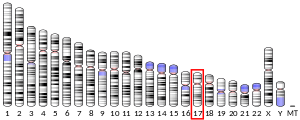OR1A1
Olfactory receptor 1A1 is a protein that in humans is encoded by the OR1A1 gene.[4][5]
| OR1A1 | |||||||||||||||||||||||||
|---|---|---|---|---|---|---|---|---|---|---|---|---|---|---|---|---|---|---|---|---|---|---|---|---|---|
| Identifiers | |||||||||||||||||||||||||
| Aliases | OR1A1, OR17-7, olfactory receptor family 1 subfamily A member 1, olfactory receptor family 1 subfamily A member 1 (gene/pseudogene) | ||||||||||||||||||||||||
| External IDs | OMIM: 618046 MGI: 1333770 HomoloGene: 8219 GeneCards: OR1A1 | ||||||||||||||||||||||||
| |||||||||||||||||||||||||
| |||||||||||||||||||||||||
| |||||||||||||||||||||||||
| Orthologs | |||||||||||||||||||||||||
| Species | Human | Mouse | |||||||||||||||||||||||
| Entrez | |||||||||||||||||||||||||
| Ensembl |
| ||||||||||||||||||||||||
| UniProt |
| ||||||||||||||||||||||||
| RefSeq (mRNA) | |||||||||||||||||||||||||
| RefSeq (protein) |
| ||||||||||||||||||||||||
| Location (UCSC) | Chr 17: 3.21 – 3.22 Mb | n/a | |||||||||||||||||||||||
| PubMed search | [2] | [3] | |||||||||||||||||||||||
| Wikidata | |||||||||||||||||||||||||
| |||||||||||||||||||||||||
Olfactory receptors interact with odorant molecules in the nose, to initiate a neuronal response that triggers the perception of a smell. The olfactory receptor proteins are members of a large family of G-protein-coupled receptors (GPCR) arising from single coding-exon genes. Olfactory receptors share a 7-transmembrane domain structure with many neurotransmitter and hormone receptors and are responsible for the recognition and G protein-mediated transduction of odorant signals. The olfactory receptor gene family is the largest in the genome. The nomenclature assigned to the olfactory receptor genes and proteins for this organism is independent of other organisms.[5]
Ligands
OR1A1 is relatively broadly tuned, meaning it responds to a relatively wide variety of different odor molecules.[6][7]
Examples of known ligands, most of which have citrus or fruity smells:[8][9]
- (S)-(−)-citronellal
- Helional
- Heptanal
- Octanal
- Nonanal (weaker than heptanal/octanal[8])
- Hydroxycitronellal
- Citral
- Citronellol (both enantiomers, weaker than citronellal[8])
- Dihydrojasmone[6]
- Thiols[7]
See also
References
- GRCh38: Ensembl release 89: ENSG00000172146 - Ensembl, May 2017
- "Human PubMed Reference:". National Center for Biotechnology Information, U.S. National Library of Medicine.
- "Mouse PubMed Reference:". National Center for Biotechnology Information, U.S. National Library of Medicine.
- Glusman G, Sosinsky A, Ben-Asher E, Avidan N, Sonkin D, Bahar A, et al. (January 2000). "Sequence, structure, and evolution of a complete human olfactory receptor gene cluster". Genomics. 63 (2): 227–45. doi:10.1006/geno.1999.6030. PMID 10673334.
- "Entrez Gene: OR1A1 olfactory receptor, family 1, subfamily A, member 1".
- Saito H, Chi Q, Zhuang H, Matsunami H, Mainland JD (March 2009). "Odor coding by a Mammalian receptor repertoire". Science Signaling. 2 (60): ra9. doi:10.1126/scisignal.2000016. PMC 2774247. PMID 19261596.
- Block, E.; Batista, V.S.; Matsunami, H.; Zhuang, H.; Ahmed, L. (2017). "The role of metals in mammalian olfaction of low molecular weight organosulfur compounds". Natural Product Reports. 34 (5): 529–557. doi:10.1039/c7np00016b. PMC 5542778. PMID 28471462.
- Schmiedeberg, K., Shirokova, E., Weber, H.-P., Schilling, B., Meyerhof, W., & Krautwurst, D. (2007). "Structural determinants of odorant recognition by the human olfactory receptors OR1A1 and OR1A2". Journal of Structural Biology. 159 (3): 400–412. doi:10.1016/j.jsb.2007.04.013.CS1 maint: uses authors parameter (link)
- Audouze K, Tromelin A, Le Bon AM, Belloir C, Petersen RK, Kristiansen K, et al. (2014). "Identification of odorant-receptor interactions by global mapping of the human odorome". PLOS ONE. 9 (4): e93037. Bibcode:2014PLoSO...993037A. doi:10.1371/journal.pone.0093037. PMC 3973694. PMID 24695519.
Further reading
- Fuchs T, Malecova B, Linhart C, Sharan R, Khen M, Herwig R, et al. (September 2002). "DEFOG: a practical scheme for deciphering families of genes". Genomics. 80 (3): 295–302. doi:10.1006/geno.2002.6830. PMID 12213199.
- Malnic B, Godfrey PA, Buck LB (February 2004). "The human olfactory receptor gene family". Proceedings of the National Academy of Sciences of the United States of America. 101 (8): 2584–9. Bibcode:2004PNAS..101.2584M. doi:10.1073/pnas.0307882100. PMC 356993. PMID 14983052.
External links
- OR1A1+protein,+human at the US National Library of Medicine Medical Subject Headings (MeSH)
This article incorporates text from the United States National Library of Medicine, which is in the public domain.


